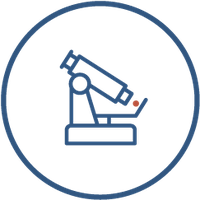Published: 20 April 2023
BioAscent has experienced a growing demand for its SPR expertise in recent months. In our latest blog, Dominika Kowalczyk, a scientist in the biosciences team, shares her reflections and experiences of SPR use in industry compared to academia.
Dominika joined the BioAscent biosciences team in May 2022. Her previous experience of using SPR to support drug discovery had been in an academic setting, at the CRUK Beatson Institute in Glasgow, where she completed her PhD, and stayed for a further two years to complete her Postdoc.
Her four-year PhD was focused on MDM2’s catalytic domain and identifying inhibitors that could be utilised for fundamental oncology research, in line with the Beatson Institute’s focus on cancer research. Taking a protein study approach, Dominika used a variety of biochemical and biophysical assays to define the interaction of the protein with small molecules, other proteins, and RNA.
At the end of her PhD Dominika was offered a Post Doc with a different group at the Beatson which presented an opportunity to apply the knowledge and experience gained during her PhD to work in drug discovery.
Her project and group were focused on PROTAC studies. Dominika was able to apply her knowledge in running SPR assays, alongside other biophysical techniques, such as fluorescence polarisation.
During her time at the Beatson, Dominika was able to push herself out of her comfort zone, and gain experience in managing projects and time. When the project came to an end, Dominika knew she wanted to find a suitable role in industry and stay in Scotland, which is where BioAscent came in.
Already aware of BioAscent, Dominika applied to join the company, and started in May 2022.
Reflecting on her transition to industry, Dominika says: “Joining a CRO opened my eyes to the huge variety of projects we are able to work on. I think my experience in academia was quite unique in many respects, but I was surprised that it wasn’t such a huge step to join BioAscent. Here I am able to run my own projects and have the freedom to try different things and I am still learning a lot from an experienced group of colleagues. I also have a lot of flexibility, so I think I have continued with the good bits from life in academia!”
At the Beatson Institute, Dominika was very fortunate to have unlimited access to their SPR machine and was able to learn and try things herself. “I am very aware that this is not the case in many academic institutes where there is sometimes no SPR, or one that is used across a number of research groups. The kit is very expensive, and it is also rare for academia to employ experienced SPR scientists from whom you can learn."
Fortunately, BioAscent has two Biacore 8k SPR Systems available for use in customers' drug discovery projects. Furthermore, the wealth of SPR expertise within the team makes it easy to share knowledge and learn from one another.
When Dominika joined, she first worked on an anti-malarial project, which she took over from a colleague. Bringing a fresh approach to the project, Dominika drew on her previous experience, running the full screen and gained new insights into how SPR experiments are run from a purely drug discovery point of view.
When comparing how SPR is used in academia and in industry, Dominika has some clear observations:
In academia, you are generally working alongside people with similar knowledge and experience, so you have a lot of self-directed learning, reading and asking a lot of questions.
Academia provides some support, but rarely a dedicated experienced SPR scientist who can train you.
In contrast, BioAscent has a team of dedicated people with a wealth of direct experience in utilising SPR in drug discovery.
In industry, the approach is more thorough with a path to follow and clear steps. It is much more controlled with more checks along the way, this helps to ensure the data is robust and we can be confident with our customers when we present that data back to them.
Academia tends to be faster-paced. Often the scientists are looking for something specific that is going to determine the whole project, and rarely is an experiment followed the whole way through.
SPR brings many benefits, but for Dominika, high throughput screening provides the most useful technique when protein samples are limited, and screening across a lot of compounds is required.
Combining her experience from academia with that gained at BioAscent, as well as the team’s wider expertise, has further strengthened BioAscent’s approach to SPR. As a team, BioAscent has the SPR capacity and expertise to support customer research programmes through all stages of the drug discovery process from early hit identification, hit optimisation through to lead candidate.
To find out more about our biochemical, biophysical and cellular assay development expertise, contact a member of the team.




